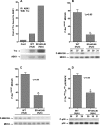The ASK1-Signalosome regulates p38 MAPK activity in response to levels of endogenous oxidative stress in the Klotho mouse models of aging
- PMID: 20844314
- PMCID: PMC2984608
- DOI: 10.18632/aging.100194
The ASK1-Signalosome regulates p38 MAPK activity in response to levels of endogenous oxidative stress in the Klotho mouse models of aging
Abstract
Reactive oxygen species (ROS) and elevated levels of p38 MAPK activity accelerate physiological aging. This emphasizes the importance of understanding the molecular mechanism(s) that link ROS production to activation of the p38 mediated promotion of aging, longevity, and resistance to oxidative stress. We examined Klotho(-/-) (elevated ROS) and Klotho overexpressing mice (low ROS and resistance to ROS) to determine whether the ROS-sensitive apoptosis signal-regulating kinase (ASK1)-signalosome -> p38 MAPK pathway plays a role in the accelerated aging of Klotho(-/-), and resistance to oxidative stress and extended lifespan in the Klotho overexpressing models. Our results suggest that increased endogenous ROS generated by Klotho(-/-) and resistance to oxidative stress in Klotho overexpression are linked to the regulation of ASK1-signalosome -> p38 activity. We propose that (a) the ASK1-signalosome -> p38 MAPK pathway is activated by oxidative stress due to ablation of the Klotho gene; (b) increased longevity by Klotho overexpression is linked to suppression of the ASK1-signalosome-p38 MAPK activity; (c) the ROS-responsive ASK1-signalosome regulates physiological aging via its regulation of p38 MAPK, through a mechanism that balances the levels of inhibitory vs. activating ASK1-signalosomes. We conclude that the Klotho suppressor-of-aging activity is linked to the ASK1-signalsome, a physiological ROS-sensitive signaling center.
Conflict of interest statement
The authors of this manuscript have no conflict of interests to declare.
Figures







Comment in
-
Linking Klotho, Nrf2, MAP kinases and aging.Aging (Albany NY). 2010 Oct;2(10):632-3. doi: 10.18632/aging.100219. Aging (Albany NY). 2010. PMID: 21076180 Free PMC article. No abstract available.
References
-
- Harman D. Aging: A theory based on free radical chemistry. Gerontol. 1956;11:298–300. - PubMed
-
- Stadtman ER. Protein oxidation and aging. Science. 1992;257:1220–1224. - PubMed
-
- Papaconstantinou J. Unifying model of the programmed (intrinsic) and stochastic (extrinsic) theories of aging. The stress response genes, signal transduction-redox pathways and aging. Ann N Y Acad Sci. 1994;719:195–211. - PubMed
-
- Sohal RS, Dubey A. Mitochondrial oxidative damage, hydrogen peroxide release, and aging. Free Radic Biol Med. 1994;16:621–626. - PubMed
Publication types
MeSH terms
Substances
Grants and funding
LinkOut - more resources
Full Text Sources
Medical
Molecular Biology Databases
Miscellaneous

